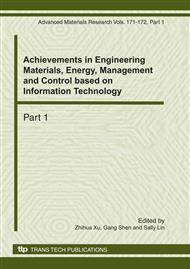[1]
Y. R. Kondareddy, P. Agrawal, and K. Sivalingam, in: Cognitive Radio Network setup without a Common Control Channel, edited by Military Communications Conference (2008).
DOI: 10.1109/milcom.2008.4753398
Google Scholar
[2]
X. F. Yan, Y. G. Sun and Y. L. Wang, in: A Heuristic Algorithm for Minimum Connected Dominating Set with Maximal Weight in Ad Hoc Networks, edited by GCC2003 (2003).
DOI: 10.1007/978-3-540-24680-0_116
Google Scholar
[3]
Y. Tang and M. T. Zhou: Maximal Independent Set Based Distributed Algorithm for Minimum Connected Dominating Set. Acta Electronica Sinica. Vol. 35 (2007), pp.868-874.
Google Scholar
[4]
W. R. Heinzelman, A. Chandrakasan and H. Balakrishman, in: Energy-Efficient Communication Protocol for Wireless Microsensor Networks, edited by IEEE HICSS (2000).
Google Scholar
[5]
Y. C. Wang, Q. C. Zhao and D. Z. Zheng, in: Energy-driven adaptive clustering data collection protocol in wireless sensor networks, edited by International Conference on Intelligent Macaronis and Automation (2004).
DOI: 10.1109/icima.2004.1384266
Google Scholar
[6]
P. Pawelczak, S. Pollin, H. So: Performance analysis of multichannel medium access control algorithms for opportunistic spectrum access. IEEE Trans. Veh. Technology. Vol. 58 (2008), p.3014–3031.
DOI: 10.1109/tvt.2008.2009350
Google Scholar
[7]
S. Bandyopahyay and E. J. Coyle, in: An Energy Efficient Hierarchical Clustering Algorithm for Wireless Sensor Networks, edited by IEEE INFOCOM (2003).
Google Scholar
[8]
H. Sarvanko, M. Mustonen, in: Cooperative and noncooperative spectrum sensing techniques using Welch's periodogram in cognitive radios, edited by in Proc. Int. Workshop CogArt, (2008).
DOI: 10.1109/cogart.2008.4509987
Google Scholar
[9]
J. H. Chang and L. Tassiulas, in: Energy Conserving Routing in Wireless Ad Hoc Networks, edited by INFOCOM (2000).
Google Scholar
[10]
V. Mhatre and C. Rosenberg: Design Guidelines for Wireless Sensor Networks: Communication, Clustering and Aggregation. Elsevier Ad Hoc Networks Journal. Vol. 2 (2004), pp.45-63.
DOI: 10.1016/s1570-8705(03)00047-7
Google Scholar


